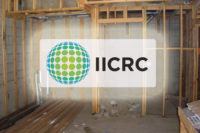The Best Risk Management Tool for Mold Remediation
New version of ANSI/IICRC S520 now available




Did you know the ANSI/IICRC S520 Professional Mold Remediation Standard is the most important risk management tool ever conceived for the mold remediation business?Is that hard to believe? I suspect many don’t know why the S520 is a risk management tool. Some may even contest the validity of the statement. In fact, while this article focuses primarily on the S520, any ANSI/IICRC standard can be a risk management tool.
It is hard to connect the dots between the S520 Standard and risk management unless you know something about the ANSI-approved consensus drafting process, and managing mold remediation risks. Let’s connect the dots.
This was my third go-around on the consensus drafting committee of the S520. I also served on the drafting committees of two editions of the S500. That experience, paired with founding an insurance brokerage firm focused on insuring restoration firms, gives me a closer look at these standards than most. In addition, I have a four technical degrees in risk management and am approved to teach insurance agents errors and omissions loss avoidance continuing education courses across the country.
ARMR helps local insurance agents insure more than one thousand mold remediation firms. In our work as specialized business insurance brokers, we have reviewed thousands of unique losses of restoration and remediation companies. This provides us with unique insight into the risks inherent in each sector -- including mold remediation.
So why does the IICRC have an insurance and risk management professional sitting on the drafting committees of the S500 and S520? It’s because every wordin those documents has been put under the microscope to avoid creating a risk management problem within the document for the remediators using it.
Every Monday afternoon for almost two years, the committee members sat in on a GoTo Meeting webcast together. The committee considered every word, comma and period in the document itself and in hundreds of public comments. The goal was to create a document that reflected the consensus best practices for an entire global industry. Because it is a consensus drafting process, it was important for committee members to be on every call. Unless there is a voting quorum of committee members present, nothing can be approved in the ANSI process.
In the consensus drafting process, all participants in a vote must reach a consensus on an item before it can be adopted. The importance of this consensus drafting process cannot be over emphasized from a risk management standpoint. The entire document represents the informed opinions of many.
Any voting member on the consensus drafting committee can object to something as simple as placement of a comma. When that happens, the entire consensus drafting committee hears the opposing and supporting views. After debate on the item under discussion, the Standard chair takes a vote on where the comma should go. The committee will keep debating and voting until there is consensus among the entire committee. Imagine the lengthy debate on something more complex, like how to objectively discuss heat drying in the document without creating a competitive advantage for anyone selling a particular brand of drying equipment.
Reaching consensus within the drafting committee all the way down to the placement of every comma in the document is one reason it can take years simply to update an IICRC standard. It is also the reason the S520 is such a great risk management tool. It completely captures what reasonable remediators would do in custom and practice at the time the document was written. The “reasonable person” defense is what remediators will need to use in court if they are sued over something that happened during a mold remediation.
Have you ever noticed there are not very many (if any) “you must do it this way” dictates in the S520? That is not an accident. The drafting committee purposely kept an eye on not setting liability traps for contractors to step into. The S520 document is written specifically to allow a knowledgeable contractor to make field decisions based on the general principles expressed in the document. The key to a managed risk is justifying the field decision to deviate from the standard on the basis of what another qualified contractor following the principles in the standard would have done in the same situation.
In practice, the S520 reduces the risk of building occupants, remediators and claims adjustors alike. Claims adjusters not following the S520 Standard are capable of creating substantial risk on a job as was best illustrated in the Ballard case in Texas over a decade ago.
The whole “toxic mold” insurance crisis 15 years ago was created by insurance claims adjusters working for Farmers Insurance Company on a homeowners insurance loss involving a leaky ice maker. Farmers insured the home owned by Melinda Ballard in Dripping Springs, Tex., under a policy with a $300,000 limit of liability. The subflooring had developed mold as a result of leaking water from the ice maker. Farmers spent a year not doing the right thing to fix the mold in the subflooring partly because they kept assigning new adjusters to the loss and partly, in my opinion, because there were no mold standards and guidelines available at the time to follow in the remediation process. After more than a year of delays in resolving the loss, Melinda Ballard sued Farmers for bad faith claims adjusting practices including punitive damages for exposing her family to toxic mold. On the first go around in the lawsuit, Ballard won a $32 million dollar judgment against Farmers for bad faith claim adjusting.
The concept that an insurance company could issue a Homeowners insurance policy with a $300,000 limit of liability and be faced with a $32 million dollar loss as a result of mold in a home made the entire insurance industry go ballistic.
Right after the Ballard case, the insurance industry slammed exceptionally broad exclusions for losses involving even the threatened existence of fungus or bacteria in a building (including category 3 water) into virtually every property and general liability insurance policy sold in the U.S. Those same exclusions also specifically eliminate general liability insurance coverage for even showing up at a mold or category 3 water jobsite!
The moral to the story: an uninformed claims adjuster set the mold insurance crisis into play. The whole issue with restoration contractors needing specialized insurance for their mold and category 3 water work today can be traced back to the uniformed claims adjusters working the Ballard claim.
It is interesting that nine out of 10 restoration contractors still purchase general liability insurance policies with mold/bacteria remediation job site exclusions. Since those firms have major holes in their liability insurance protection, adherence to the S520 document is even more important. By the way, no Contractors Pollution Insurance on the planet can fix the GL coverage job site exclusion. There are specialty package insurance policies that fix the coverage gaps. If you have a separate insurance company on the GL and CPL policies, you have insurance coverage issues and need to pay even more attention to the S520.
There are other mold remediation guidelines that also provide very good advice. A few years ago Dr. Michael Pinto published a comparison of the most popular mold remediation guidelines. His conclusion was they all followed the same basic principles. Some of these guidelines no doubt will be more useful on some jobs than the S520. More important than following any of the standard and guidelines to the letter is not to deviate from the basic mold remediation principles followed by all of them. Where you do not want to find yourself is sitting in court trying to explain why you decided to do something a certain way on a mold job that goes against to the consensus opinion that produced the principles contained in S520 standard in the first place.
Following the basic mold remediation principles of S520 and other industry standards should make you bulletproof from claims alleging negligence on a mold remediation project gone wrong. But the IICRC standards and guidelines can be a double edged sword; the same document that protects a contractor from liability can be used equally effectively against contractors (and claims adjusters) as proof of negligence if they do not follow the principles expressed in the document.
My advice: do the work by the book as much as you can. If a job site condition dictates a deviation from the IICRC standards, be sure to follow the general principles of mold or water remediation in use today. Plus, be sure your insurance policies are in check!
Looking for a reprint of this article?
From high-res PDFs to custom plaques, order your copy today!







